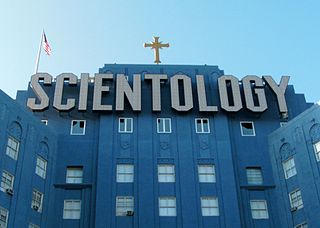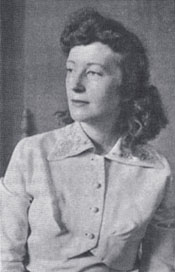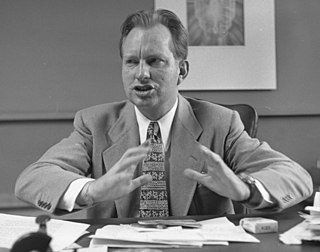Related Research Articles

Lafayette Ronald Hubbard was an American author, primarily of science fiction and fantasy stories, who is best known for having founded the Church of Scientology. In 1950, Hubbard authored Dianetics: The Modern Science of Mental Health and established a series of organizations to promote Dianetics. In 1952, Hubbard lost the rights to Dianetics in bankruptcy proceedings, and he subsequently founded Scientology. Thereafter, Hubbard oversaw the growth of the Church of Scientology into a worldwide organization.

Xenu, also called Xemu, is a figure in the Church of Scientology's secret "Advanced Technology", a sacred and esoteric teaching. According to the "Technology", Xenu was the extraterrestrial ruler of a "Galactic Confederacy" who brought billions of his people to Earth in DC-8-like spacecraft 75 million years ago, stacked them around volcanoes, and killed them with hydrogen bombs. Official Scientology scriptures hold that the thetans of these aliens adhere to humans, causing spiritual harm.

In Scientology, the concept of the thetan is similar to the concept of self, or the spirit or soul as found in several belief systems. The term is derived from the Greek letter Θ, theta, which in Scientology beliefs represents "the source of life, or life itself." In Scientology it is believed that it is the thetan, not the central nervous system, which commands the body.

Mary Sue Hubbard was the third wife of L. Ron Hubbard, from 1952 until his death in 1986. She was a leading figure in Scientology for much of her life. The Hubbards had four children: Diana, Quentin (1954–1976), Suzette, and Arthur.
Revolt in the Stars is a science fiction film screenplay written by Scientology founder L. Ron Hubbard in 1977. It tells the space opera story of how an evil galactic dictator, named Xenu, massacres many of his subjects by transporting them to Earth and killing them with atomic bombs. L. Ron Hubbard had already presented this story to his followers, as a true account of events that happened 75 million years ago, in a secret level of Scientology scripture called Operating Thetan, Level III. The screenplay was promoted around Hollywood circles in 1979, but attempts at fundraising and obtaining financing fell through, and the film was never made. Unofficial copies circulate on the Internet.

Scientology founder L. Ron Hubbard explicitly compared his teachings to the science-fiction subgenre space opera. In his writings, wherein thetans were reincarnated periodically over quadrillions of years, retaining memories of prior lives, to which Hubbard attributed complex narratives about life throughout the universe. The most controversial of these myths is the story of Xenu, to whom Hubbard attributed responsibility for many of the world's problems.
The Commodore's Messenger Organization (CMO) is an elite organization within the Sea Org, an unincorporated paramilitary wing of the Church of Scientology, described by the Church as a "fraternal religious order" comprising the most dedicated Scientologists. Its members communicate and enforce policies of the Religious Technology Center.

Ronald Edward "Ron" DeWolf, also known as "Nibs" Hubbard, was the eldest child of Scientology's founder L. Ron Hubbard by his first wife Margaret Louise Grubb. He is known for having been highly critical of his father and of the Church of Scientology.
An engram, as used in Dianetics and Scientology, is a detailed mental image or memory of a traumatic event from the past that occurred when an individual was partially or fully unconscious. It is considered to be pseudoscientific and is different from the meaning of "engram" in cognitive psychology. According to Dianetics and Scientology, from conception onwards, whenever something painful happens while the "analytic mind" is unconscious, engrams are supposedly being recorded and stored in an area of the mind Scientology calls the "reactive mind".
According to Church of Scientology doctrine, Helatrobus was an "interplanetary nation", now extinct, which existed trillions of years ago.

A Piece of Blue Sky: Scientology, Dianetics and L. Ron Hubbard Exposed is a 1990 book about L. Ron Hubbard and the development of Dianetics and Scientology, authored by British former Scientologist Jon Atack. It was republished in 2013 with the title Let's sell these people A Piece of Blue Sky: Hubbard, Dianetics and Scientology. The title originates from a quote of Hubbard from 1950; an associate of Hubbard's noted him saying that he wanted to sell potential members "a piece of blue sky".

Scientology: A History of Man is a book by L. Ron Hubbard, first published in 1952 under the title What to Audit by the Scientific Press of Phoenix. According to the author, it provides "a coldblooded and factual account of your last sixty trillion years." It has gone through many editions since its first publication and is a key text of the Church of Scientology. The book has been ridiculed by critics of Scientology for its unusual writing style and pseudoscientific claims; it has been described as "a slim pretense at scientific method ... blended with a strange amalgam of psychotherapy, mysticism and pure science fiction; mainly the latter."
OT VIII or OT 8 is the highest current auditing level in Scientology. OT VIII is known as "The Truth Revealed" and was first released to select high-ranking public Scientologists in 1988, two years after the death of Scientology's founder, L. Ron Hubbard. OT VIII is only delivered to members of the Church of Scientology in one place—aboard the organization's private cruise ship, the Freewinds, and is additionally available from independent Scientology groups. There are a few advanced auditors that are able to deliver the level to those who meet the prerequisites.

The Scandal of Scientology is a critical exposé book about the Church of Scientology, written by Paulette Cooper and published by Tower Publications, in 1971.
According to the beliefs of the Church of Scientology, the Marcab Confederacy is said to be one of the most powerful galactic civilizations still active. Church founder L. Ron Hubbard describes it as:
Various planets united into a very vast civilization which has come forward up through the last 200,000 years, formed out of the fragments of earlier civilizations. In the last 10,000 years they have gone on with a sort of decadent kicked-in-the-head civilization that contains automobiles, business suits, fedora hats, telephones, spaceships — a civilization which looks almost an exact duplicate but is worse off than the current US civilization.
The relationship between Scientology and religious groups is very complex. While Scientology claims that it is fully compatible with all existing major world religions and that it does not conflict with them or their religious practices, there are significant contradictions between Scientology and most religions, especially the major monotheistic religions. Members are not allowed to engage in other similar mental therapies or procedures, religious or otherwise. However, some ministers from other churches have adopted some Scientology secular programs.
The intersection of Scientology and abortion has a controversial history which began with Scientology founder L. Ron Hubbard's discussion of abortion in his 1950 book Dianetics: The Modern Science of Mental Health. Hubbard wrote in Dianetics that abortion and attempts at abortion could cause trauma to the fetus and to the mother in both spiritual and physical ways. Scientologists came to believe that attempted abortions could cause traumatic experiences felt by the fetus, which would later be remembered as memories referred to in Scientology as "engrams". In the Scientology technique called Auditing, Scientologists are frequently queried regarding their sexual feelings and behaviors. These questions about Scientologists' sexual behavior are often posed to members during "security checks", a specific form of auditing sessions where individuals are required to document their divergence from the organization's ethics. One of the questions asked in these security checks is, "Have you ever been involved in an abortion?".
Pat Broeker, a former high-ranking member of the Church of Scientology, was – along with his wife Annie Broeker – one of the few people in direct contact with L. Ron Hubbard as he became isolated from the public and even from Scientology during his final years.

Scientology is suspected or alleged by some observers of being inspired by, or sharing elements with, a number of esoteric or occult systems.
This is a bibliography of books critical of Scientology and the Church of Scientology, sorted by alphabetical order of titles.
References
- 1 2 Hubbard, L. Ron (July 19, 1954), Scientology, Its General Background (lecture),
Now, the Hebrew definition of messiah is "one who brings wisdom"-a teacher, in other words. Messiah is from messenger. But he is somebody with information. Moses was such a one. And then Christ became such a one. He was a bringer of information. He never announced his sources. He spoke of them as coming from God. But they might just as well have come from the god talked about in the Hymn to the Dawn Child, who, by the way, is rather hard to distinguish from gods talked about later on. He's certainly not the Hebrew God, the God the Christians worshiped. He looks more like that one talked about in the Veda. He looks much more like it.
- 1 2 Corydon, Bent (1987). L. Ron Hubbard, Messiah or Madman?. Lyle Stuart. p. 353. ISBN 0818404442.
- 1 2 Urban, Hugh (2021). "The Third Wall of Fire". Secrecy: Silence, Power, and Religion. Chicago/London: University of Chicago Press. pp. 165–186. ISBN 978-0-226-74650-0.
- ↑ Hubbard, L. Ron Scientology Definitions II, 6612C06, SH Spec 83, 1966.
- ↑ Driscoll, Mark (2007). Vintage Jesus. pp. 14, 183. ISBN 9781581349757. OL 12280598M.
According to Scientology, Jesus is an "implant" forced upon a Thetan about a million years ago. ... If you are a Scientologist, apparently Tom Cruise is your savior. The head of Scientology, David Miscavige, was the best man at Tom's wedding to Katie Holmes. Miscavige said that he "believes that in [the] future, Cruise will be worshiped like Jesus for his work to raise awareness of the religion."
- ↑ Huberman, Jack (2006). 101 People Who Are Really Screwing America. Nation Books. pp. 51. ISBN 9781560258759. OL 8615550M.
- ↑ Atack, Jon (1990). A Piece of Blue Sky: Scientology, Dianetics and L. Ron Hubbard Exposed. Lyle Stuart Books. p. 376, 383. ISBN 081840499X. OL 9429654M.
Despite its claims to be nondenominational, and to welcome members of all religions, Scientology is essentially anti-Christian. In confidential materials Hubbard attacked Christianity as an "implant," and said that Christ was a fiction. ... Hubbard's Scientology morality is opposed to Christianity. Certain basic Christian values are despised by the Scientologist, who considers them misconceived. ... In Scientology, there is no concept of God, nor of grace. The Scientologist is in every respect a self-made Thetan. Nor is Scientology compatible with the beliefs of other faiths.
- ↑ Sappell, Joel; Welkos, Robert W. (June 24, 1990). "Defining the Theology". Los Angeles Times.
- 1 2 Hubbard, L. Ron (May 5, 1980). "Confidential: Student Briefing, OT VIII Series I". Transcribed from original copies at US District Court, Central District of California, Fishman Case No 91-6426 HLH (Tx) – via David S. Touretzky.
- ↑ Wakefield, Margery (1991). "What Christians Need to Know about Scientology". David S. Touretzky .